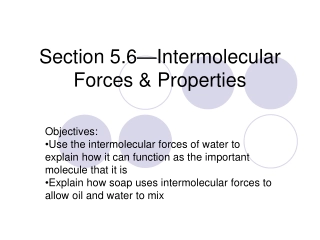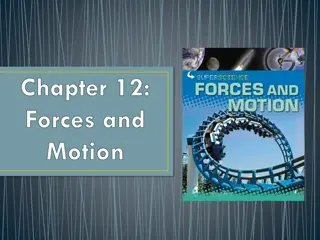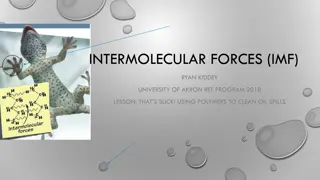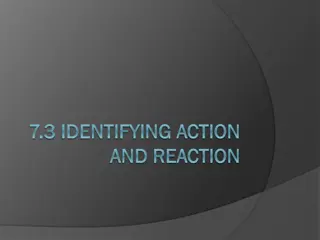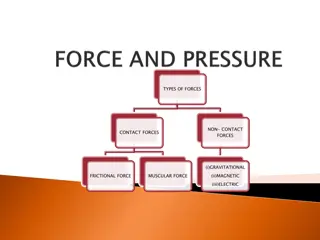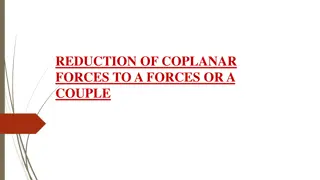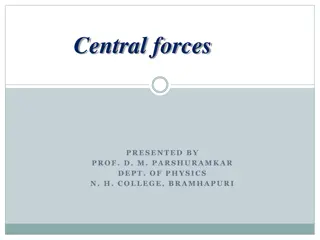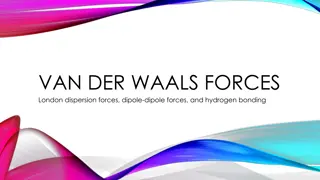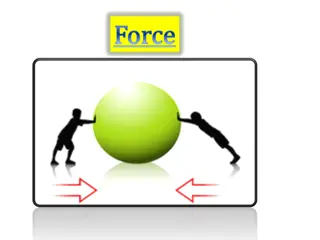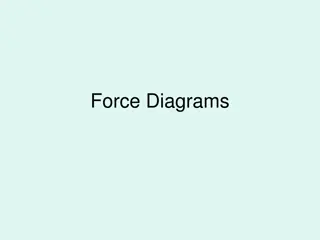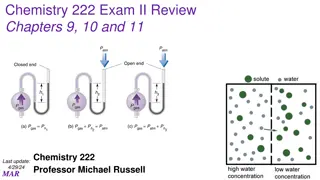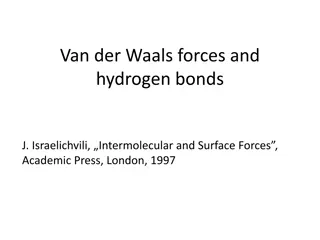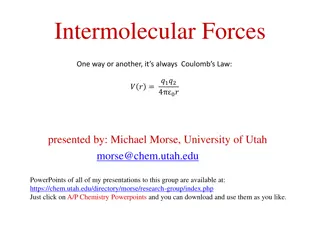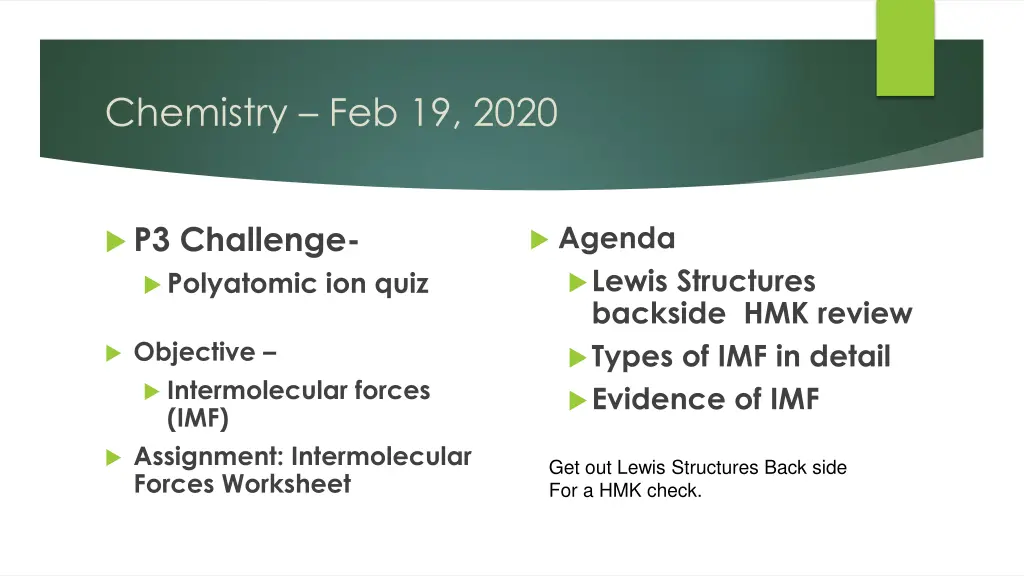
Understanding Intermolecular Forces in Chemistry
Explore the various types of intermolecular forces (IMF) in chemistry, including covalent network compounds, ionic compounds, metals, and hydrogen bonds. Learn about the different strengths and presence of these IMFs in different substances. Dive into the realm of molecular structures and IMF interactions to deepen your understanding of chemical bonding.
Download Presentation

Please find below an Image/Link to download the presentation.
The content on the website is provided AS IS for your information and personal use only. It may not be sold, licensed, or shared on other websites without obtaining consent from the author. If you encounter any issues during the download, it is possible that the publisher has removed the file from their server.
You are allowed to download the files provided on this website for personal or commercial use, subject to the condition that they are used lawfully. All files are the property of their respective owners.
The content on the website is provided AS IS for your information and personal use only. It may not be sold, licensed, or shared on other websites without obtaining consent from the author.
E N D
Presentation Transcript
Chemistry Feb 19, 2020 P3 Challenge- Polyatomic ion quiz Agenda Lewis Structures backside HMK review Types of IMF in detail Evidence of IMF Objective Intermolecular forces (IMF) Assignment: Intermolecular Forces Worksheet Get out Lewis Structures Back side For a HMK check.
Types of Inter/Intra IMF Type of force Relative strength Present in Example Covalent network bonding Only a few select substances Strongest C Ionic bonding Any ionic substances Very strong NaCl Variable strength, some very strong Metallic bonding Metals and alloys Fe
Types of Pure IMF Type of force Relative strength Present in Example Molecules having H bonded to F, O, or N Hydrogen Bond Strong HF Dipole Dipole force Only polar molecules Moderate CO Weak, but increases with molar mass All atoms and molecules Dispersion force H2
Covalent Network Compounds Covalent Bonds are most often found intramolecular in molecular solids. The only time they are found as intermolecular is with a very few covalent network solids, like carbon C (diamond) or silicon dioxide SiO2 (glass/quartz) or SiC (silicon carbide) Intramolecular covalent bonds are quite strong, but generally not as strong as ionic bonds. Intermolecular covalent network bonds are the strongest of all.
Ionic Compounds The next strongest IMF occur for ionic solids. Intermolecular forces and intramolecular forces are identical for these compounds. The IMF is an electrostatic coulomb force that is present between any two oppositely charged species. a) proportional to both charges. (higher charges, higher IMF) b) inversely proportional to the square of the distance between charges (bigger atoms, lower IMF)
Metals Variable strength from strong to very strong. Both inter- and intra-. In general, a metal bond is formed between atoms of a metallic element. If more than one type of element is present, it is called an alloy. The bond can be described as fixed positive nuclei with a surrounding soup of electrons. The valence electrons of all nuclei contribute to the soup, but are not delegated to any region or specific nucleus. These delocalized electrons explain why metals conduct electricity.
Hydrogen Bonds Hydrogen Bonds are not bonds but are considered the strongest of the purely intermolecular forces. H-bonds are found intramolecular only within very large biological molecules (e.g. protein folding, DNA helix). They are represented on skeletal structures as a half solid, half dotted line. They are always formed as a hydrogen bridge between two electronegative atoms (N, O, F). The hydrogen must be covalently bonded to one of the two electronegative atoms. X H X
Hydrogen Bonds Occur in polar molecules that contain a Hydrogen bonded to fluorine, oxygen or nitrogen. Ex: HF, H2O, NH3, alcohols: R-OH, amines: R-NH2 R = any carbon-hydrogen chain Water forms the strongest Hydrogen bonds because each oxygen atom can form two hydrogen bonds.
Dipole-dipole forces Polar bonds create partial charges within their molecules. The partial charges can then attract one another electrostatically. These intermolecular forces are called dipole- dipole interactions.
Dispersion/London/ Induced-dipole forces If no other type of interaction is present, there is still an intermolecular force, though extremely weak. Only force present in atomic solids. Multiple names for the same phenomenon Dispersion forces, London forces (named for Fritz London, not the city), Induced dipole induced dipole When two neutral atoms approach one another, the region in-between is avoided by electrons. This creates a slight induced dipole due to the presence of another nucleus. These induced dipoles can then interact and attract one another.
Strength of the Dispersion Force Ex: Noble gases. Strength of the dispersion force gets larger with larger molecules. Strength of the dispersion force gets larger with the longer molecule shapes.
Evidence of IMF In general, solids have the strongest IMF, gases have the weakest The stronger the IMF the higher the melting point and the higher the boiling point. as a gas, the lower the vapor pressure (partial pressure of vapor in equilibrium with liquid or solid in a closed container at a fixed temperature). as a liquid, the higher the viscosity and the higher the surface tension
Exit Slip - Homework Exit Slip: Which of these molecules would have the highest boiling point? Justify your choice. HO-OH, hydrogen peroxide CH3OH, methanol CH3SH, methane thiol What s Due? (Pending assignments to complete.) Intermolecular forces Worksheet What s Next? (How to prepare for the next day) Read Holt p385-392

